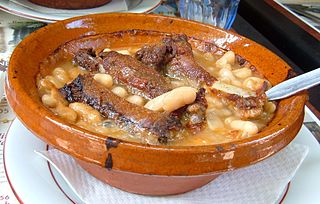Cassoulet

Cassoulet served in Carcassonne
in cassole sized for single serving |
|
| Type | Stew or casserole |
|---|---|
| Place of origin | France |
| Main ingredients | Meat (typically pork sausages, goose, duck, sometimes mutton), pork skin, white haricot beans |
| |
|
Cassoulet (French pronunciation: [ka.su.lɛ], from Occitan caçolet [kasuˈlet]) is a rich, slow-cooked casserole originating in the south of France, containing meat (typically pork sausages, goose, duck and sometimes mutton), pork skin (couennes) and white beans (haricots blancs).
The dish is named after its traditional cooking vessel, the cassole, a deep, round, earthenware pot with slanting sides.
The region once known as the province of Languedoc is the traditional homeland of cassoulet, especially the towns of Toulouse, Carcassonne, and Castelnaudary, the town which claims to be where the dish originated. All are made with white beans (haricots blancs or lingots), duck or goose confit, sausages, and additional meat. In the cassoulet of Toulouse, the meats are pork and mutton, the latter frequently a cold roast shoulder. The Carcassonne version is similar but doubles the portion of mutton and sometimes replaces the duck with partridge. The cassoulet of Castelnaudary uses a duck confit instead of mutton.
In France, cassoulets of varying price and quality are also sold in cans and jars in supermarkets, grocery stores and charcuteries. The cheapest ones contain only beans, tomato sauce, sausages, and bacon. More expensive versions are likely to be cooked with goose fat and to include Toulouse sausages, lamb, goose, or duck confit.
...
Wikipedia
